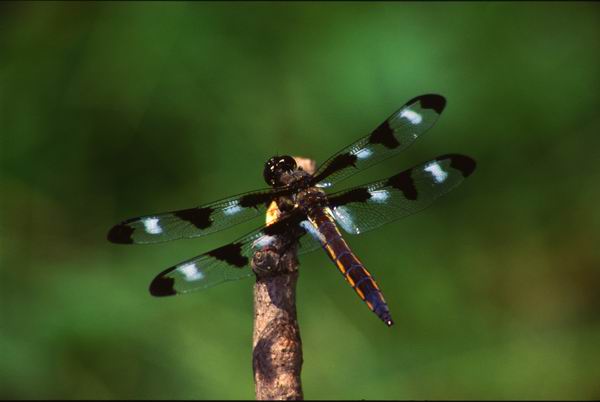
DRAGONFLIES
Stalking
the Aerial Gladiators of the Marsh
By Jim Moerschel
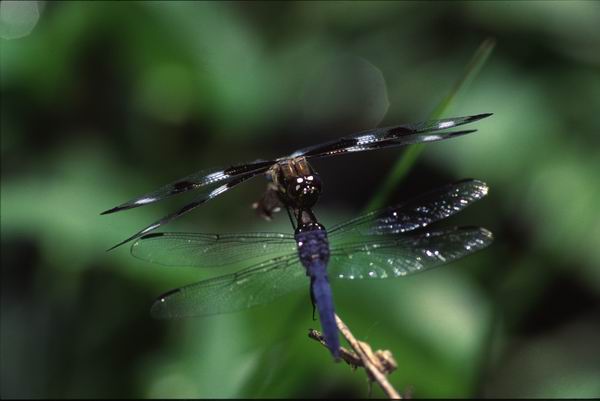
As a boy growing up in the
country, I recall spending countless hours on hot summer days
around a woodland pond where nimbled fingered 8 year old boys caught turtles,
frogs, toads,
spiders, grasshoppers and every conceivable creature within reach. But
I never remember
any of us ever catching those shimmering, darting dragonflies that patrolled
the shoreline
of our pond.
While photographing near a swamp in the summer of 1987,
I rekindled my boyhood fascination
of these flashing, shimmering predators. Of course, the
first step in photographing
any wild creature is to first learn as much as one can about their habits.
There are nearly 5000 species of dragonflies in the world and more than
300 in the United
States. Included in this family are narrow-winged and broad-winged damselflies,
common
skimmers, darners and club-tails. As I practiced stalking these creatures
I figured out why as
a kid I never caught any of them. They have the greatest sight in the
insect world. Large,
bulging compound eyes containing thousands of receptors called ommatidia
give them their
extraordinary vision. In addition, they can swivel the head freely in
almost any direction and
naturalists believe they can perceive motion at up to 40 feet away. So,
getting close to one is
not very easy.
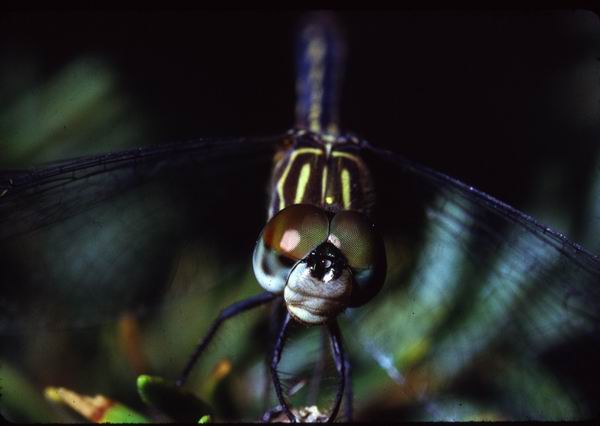
Photographing dragonflies can be done at anytime of
the day with good results. Let’s start
with daybreak. With the sun low on the horizon I begin my walk through
a field, meadow
or swamp with the sun to my back. This allows me to not have glare in
my vision path and
the sunlight will illuminate the subject. The morning is also cool and
dragonflies are waiting
for the rising sun to warm the thorax muscles to allow flight. So they
can be found clinging
amongst the reeds and tall grass chilled enough to allow the photographer
a close approach.
Many of my best closeups have been done in the cooler time of day and
I’ve been able to
poke a 55mm macro lens and flash up to just a few inches away from these
skitterish little
critters. Over the years I’ve used several different camera/lens/flash
setups to capture dragonflies in a variety of habitats. Each has its good
points and bad points.
The first setup is to use a true macro lens that will
yield high magnification. My first lens
was a 55mm macro and I also used extension tubes to increase the magnification
depending on
my desired image. A single flash unit was attached to a flash bracket
that would place the flash
just over the lens and pointing to the tiny subject. With the single flash
being the primary
source of light and with an f-stop set at f16 good depth of field was
achieved. The main objection
with this system is that black backgrounds happen if there is no foliage
within a few inches of
the dragonfly.
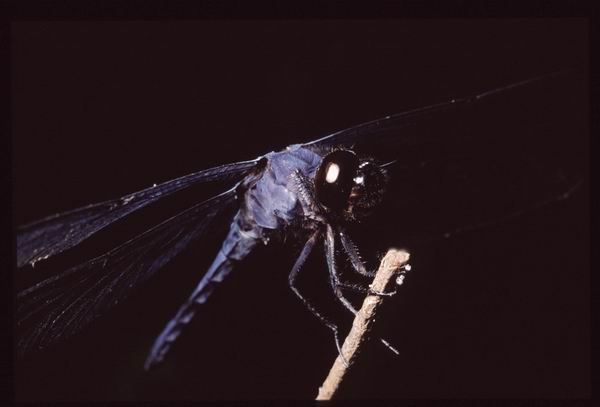
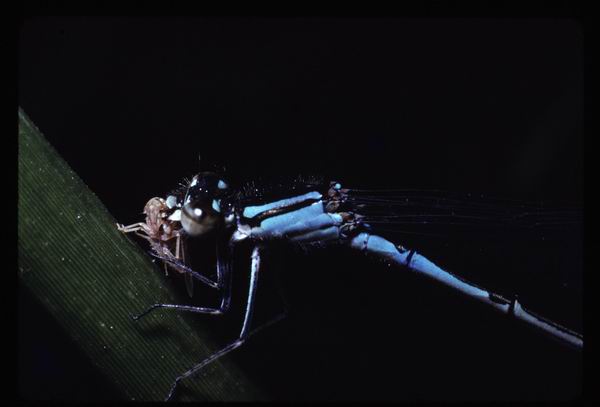
This creates the feeling of a night scene, which
of course it is not.
By adding a second flash unit onto a specially built bracket the photographer
can aim
the second flash toward the foliage just beyond the dragonfly and with
this lighting
setup create images with a better illuminated background. This yields
a photo that depicts a
more realistic situation. This was the type of setup that was employed
for several years before
the modern generation cameras came along with matrix metering and auto
focus.
Today, the newer generation
cameras allow for more diversified shooting modes to
accomplish the goal of capturing these flashing gladiators of the swamp.
My Nikon N90s
and SB25 flash unit work nicely along with a variety of macro lenses to
do the job. A 180mm
or 200mm lens is a nice focal length to allow for nice magnification of
the subject and also
allows the photographer to stay back a little so as not to scare the dragonfly
off its perch.
I’ve also used a more unconventional setup using my close focus
400mm lens with one
extension tube to allow me to focus even closer than the lens would normally
allow. I mount
the flash onto the N90s hot shoe, place a diffuser onto the flash unit
to soften and spread the
light and place the rig onto my regular Bogen tripod. This sounds at first
like it would be
almost impossible to use, but in the right habitat it works very well.

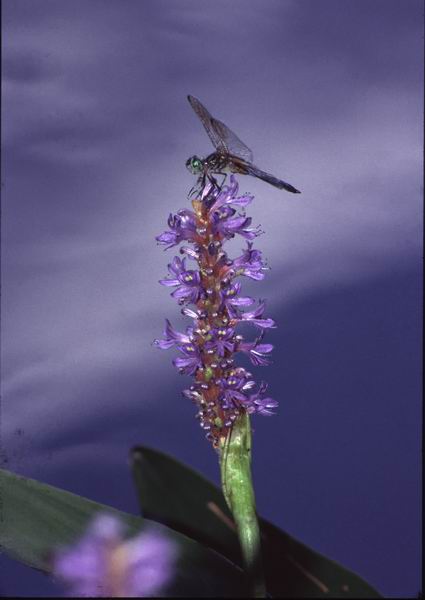
I have a nice pond deep in the woods near my home that
serves as a great spot to find
and create dragonfly photos. Male dragonflies occupy a certain territory
around the perimeter
of the pond and each finds a branch or twig that is high up within its
domain to see potential
prey, rest or look out for predators or even rival males. These “favorite
perches” are what
I look out for. A male will fly off for a short period, catch a meal,
chase a rival and will return
back to the exact perch once again.
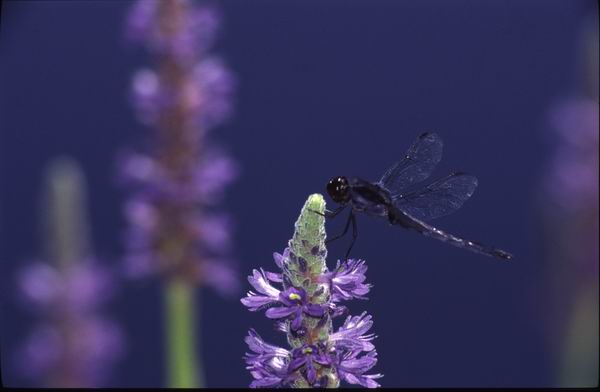
The strategy that I employ is to move my tripod very
slowly to about 7 feet away and stop.
I allow the dragonfly to get used to me being here and relax a bit. If
it flies off to feed, I will take
a nice “giant” step forward and freeze. By now the male has
returned to the perch. The next
time he leaves I move much closer and freeze like a “tree.”
When he returns I am motionless
and remain like that for awhile allowing him to accept me into the scene
as a “no threat” tree.
I begin to frame the subject, check my background, decide if I want to
shoot it vertical
or horizontal and decide whether my image size is desirable. If it is
not and I have to move
closer, I wait until the dragonfly leaves again and make any adjustments.
When he returns
I begin to shoot images. The electronic flash supplements the natural
sunlight nicely. I shoot
in aperture priority mode, set the lens at f11 and the rest is up to the
camera. I get to compose
and create.
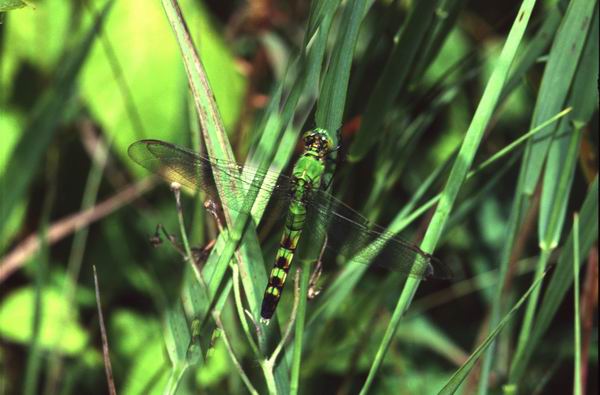
I move about the entire perimeter of the pond in this
manner. The tripod is pushed along
in range of the next dragonfly and the same stalking technique is used.
There are always frogs
about and they become targets as well. Sometimes a small water snake will
be spotted and the long lens with close focus ability brings in a nice
image. By completing one revolution around
the pond will give me several nice images from different vantage points.
Since the dragonflies domain is both watery and muddy,
waterproof boots or fishing waders
can be handy to wear. I prefer old worn out sneakers, no socks and I wear
shorts. This allows
me decent footing and I don’t care about getting my feet wet. It’s
a hot summer day anyway,
so I slog around the shallows with my tripod or handheld unit to capture
photos that I would
not be able to get from the bank. Plus it’s a lot more fun.
Besides their acute vision, dragonflies will react strongly
to vibrations, such as the photographer accidentally brushing the bush
where it is perched. They will also react to
changes in light, so it is also important to avoid casting a shadow onto
the dragonfly if the
sun is over the shoulder. The idea is to move slow and be part of the
environment and they
will allow an approach.
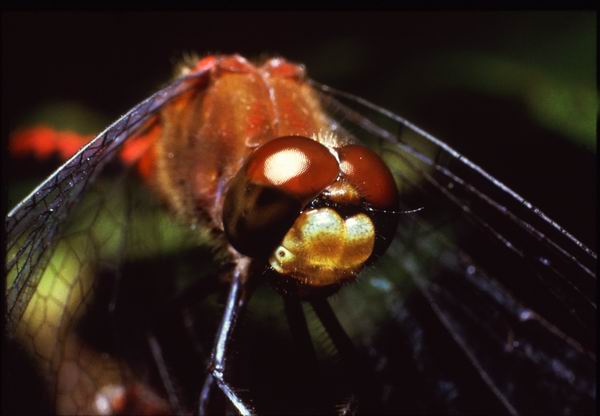
During the early part of the summer the dragonflies
are in good shape and make nice
looking subjects, but toward the end of the season they have many scars
to show for the
gladiator wars they engage in. Males have to fight off rival males of
their species all vying
to occupy a favored territory and they sustain injuries to wings and legs.
While dragonfliesfly at one level over the pond catching and eating many
small insects, they are being watched
from a higher level by birds. Swallows swoop down in graceful arching
dives and snap them
up if a dragonfly is careless.
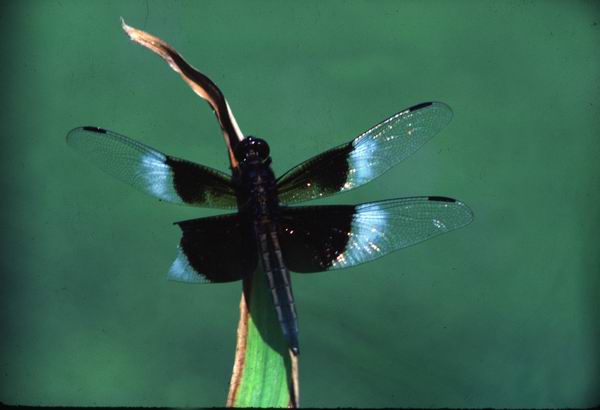
Many times the speedy and agile dragonflies escape
death, but
suffer a clipped wing. I have seen many of the shimmering gladiators with
one wing snipped
completely off. The injured dragonfly still can catch prey in this condition,
but it is never
quite as quick as it was before and eventually the relentless birds will
be victorious. I’ve
included a photo of a widow dragonfly with one wing clipped and this makes
a nice documentary
of the perils that they endure.
During mid to late summer one can witness the females
laying their fertilized eggs on
just about any pond. After being fertilized by a male, the female will
fly out over the pond
and drop near the surface of the water and flick her abdomen in a “slapping”
motion allowing
the eggs to drop out into the depths of the pond. The male will accompany
her and guard her
and even some times supports the female just above the surface. It is
at this time the female
is most vulnerable to being snatched by an alert fish lurking just below
hidden in the reeds or
lily pads.
For some really interesting photos, try facing the low
sun and find a dragonfly with
the resulting back-lighting illuminating the wings. The on-camera flash
unit will become
the main front-light to light up the near side of the dragonfly and a
nice image will be added
to your collection. Sometimes silhouettes can be very affective. With
the same back-lighting
situation turn off the on-camera flash unit and make sure the dragonfly
is positioned against
a lighter background that is in the direct sunlight. A profile shot is
better to show the body
of the subject and by spot metering the lighter background to obtain the
exposure a nice dark
subject will be silhouetted against the background.
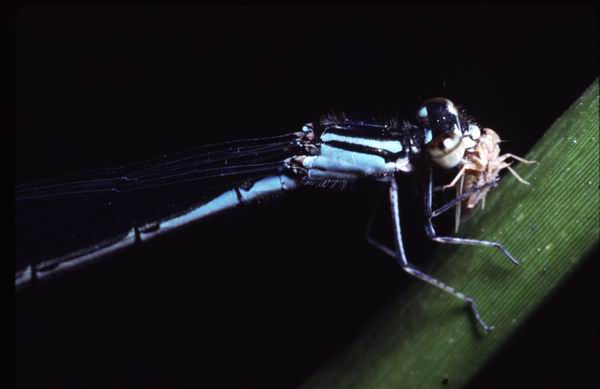
Photographing these fascinating insects has always been
a pleasurable experience,
both satisfying a primeval urge to hunt and providing me with a nostalgic
sense of adventure
as I explored the miniature world with my macro lenses. Of greater importance,
it satisfied
my need to communicate a message about nature – of its beauty, its
creatures, its serenity,
its fragility, and yes, of its harshness. For a moment at least, it is
again, a hot summer day
around a woodland pond and my hands are again those of a nimbled fingered
8 year old boy
still trying to catch that elusive dragonfly.